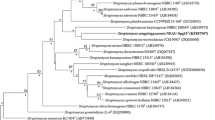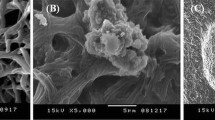Abstract
A novel endophytic actinomycete with antagonistic activity against various phytopathogenic fungi, designated strain p1417T, was isolated from the root of cattail (Typha angustifolia L.) collected from Yunnan Province, Southwest China. A polyphasic taxonomic study was carried out to establish the taxonomic status of this strain. Strain p1417T was found to have morphological and chemotaxonomic characteristics typical of the genus Streptomyces. The diamino acid present in the cell wall was LL-diaminopimelic acid. Xylose and arabinose occurred in whole cell hydrolysates. The menaquinones were identified as MK-9(H8), MK-9(H6) and MK-9(H4). The polar lipid profile was found to contain diphosphatidylglycerol, phosphatidylethanolamine, phosphatidylinositol and phosphatidylinositol mannoside. The major fatty acids were found to be iso-C16:0, anteiso-C15:0, iso-C15:0 and C16:0. The genomic DNA G + C content of strain p1417T based on the genome sequence was 72.0 mol%. Based on 16 S rRNA gene, five housekeeping genes and whole genome sequences analysis, strain p1417T was most closely related to Streptomyces flavofungini JCM 4753T (99.4% 16 S rRNA gene sequence similarity), Streptomyces alboflavus JCM 4615T (98.8%) and Streptomyces aureoverticillatus JCM 4347T (98.2%). However, the average nucleotide identity values, the digital DNA–DNA hybridization values and the multilocus sequence analysis evolutionary distances between this strain and its closely related strains showed that it belonged to one distinct species. In addition, these results were also supported by differences in the phenotypic and chemotaxonomic characteristics between strain p1417T and three closely related type strains. Therefore, it is concluded that strain p1417T represents a novel species of the genus of Streptomyces, for which the name Streptomyces typhae sp. nov. is proposed. The type strain is p1417T (= CCTCC AA 2019091T = DSM 110636T).




Similar content being viewed by others
Abbreviations
- ANI:
-
Average nucleotide identity
- dDDH:
-
Digital DNA–DNA hybridization
- ISP:
-
International Streptomyces Project
- ISCC-NBS:
-
Inter-society color council-national bureau of standards
- SSC:
-
Saline-sodium citrate
- GC-MS:
-
Gas Chromatography-Mass Spectrometer
- MEGA:
-
Molecular evolutionary genetics analysis
- MLSA:
-
Multilocus sequence analysis
- gyrB:
-
DNA gyrase subunit B
- trpB:
-
Tryptophan synthase, beta subunit
- atpD:
-
ATP synthase F1, beta subunit
- recA:
-
Recombinase A
- rpoB:
-
RNA polymerase, beta subunit
References
Barka EA, Vatsa P, Sanchez L, Gaveau-Vaillant N, Wezel GPV (2015) Taxonomy, physiology, and natural products of actinobacteria. Microbiol Mol Biol R 80:1–43
Berendsen RL, Pieterse CMJ, Bakker PAHM (2012) The rhizosphere microbiome and plant health. Trends Plant Sci 17:478–486
Blin K, Wolf T, Chevrette MG, Lu X, Schwalen CJ, Kautsar SA, Duran HGS, Santos ELCDL, Kim HU, Nave M, Dickschat JS, Mitchell DA, Shelest E, Breitling R, Takano E, Lee SY, Weber T, Medema MH (2017) Antismash 4.0-improvements in chemistry prediction and gene cluster boundary identification. Nucleic Acids Res 45:36–41
Chun J, Rainey FA (2014) Integrating genomics into the taxonomy and systematics of the Bacteria and Archaea. Int J Syst Evol Microbiol 64:316–324
Coil D, Jospin G, Darling AE (2015) A5-miseq: an updated pipeline to assemble microbial genomes from Illumina MiSeq data. Bioinformatics 31:587–589
Collins MD (1985) Chemical methods in bacterial systematics. In: Goodfellow M, Minnikin DE (eds) Isoprenoid quinone analyses in bacterial classification and identification. Academic Press, London, pp 267–284
Felsenstein J (1981) Evolutionary trees from DNA sequences: a maximum likelihood approach. J Mol Evol 17:368–376
Felsenstein J (1985) Confidence limits on phylogenies: an approach using the bootstrap. Evolution 39:83–791
Genilloud O (2017) Actinomycetes: still a source of novel antibiotics. Nat Prod Rep 34:1203–1232
Gordon RE, Barnett DA, Handerhan JE, Pang C (1974) Nocardia coeliaca, Nocardia autotrophica, and the nocardin strain. Int J Syst Bacteriol 24:54–63
Hamzah TNTH, Lee SY, Hidayat A, Terhem R, Faridah-Hanum I, Mohamed R (2018) Diversity and characterization of endophytic fungi isolated from the tropical mangrove species, Rhizophora mucronata, and identification of potential antagonists against the soil-borne fungus, Fusarium solani. Front Microbiol 9:1707
Jia FY, Liu CX, Wang XJ, Zhao JW, Liu QF, Zhang J, Gao RX, Xiang WS (2013) Wangella harbinensis gen. nov., sp. nov., a new member of the family Micromonosporaceae. Antonie Van Leeuwenhoek 103:399–408
Jin LY, Zhao Y, Song W, Duan LP, Jiang SW, Wang XJ, Zhao JW, Xiang WS (2019) Streptomyces inhibens sp. nov., a novel actinomycete isolated from rhizosphere soil of wheat (Triticum aestivum L.). Int J Syst Evol Microbiol 69:688–695
Jones KL (1949) Fresh isolates of actinomycetes in which the presence of sporogenous aerial mycelia is a fluctuating characteristic. J Bacteriol 57:141–145
Kämpfer P (2012) Genus I. Streptomyces. In: Goodfellow M, Kämpfer P, Busse H-J, Trujillo ME, Suzuki K, Ludwig W, Whitman WB (eds) Bergey’s manual of systematic bacteriology, the Actinobacteria, vol 5, 2nd edn. Springer, New York, pp 1455–1462
Kelly KL (1964) Inter-society colour council-national bureau of standards colour-name charts illustrated with centroid colours published in US
Kimura M (1980) A simple method for estimating evolutionary rates of base substitutions through comparative studies of nucleotide sequences. J Mol Evol 16:111–120
Klykleung N, Yuki M, Takuji Kudo T, Ohkuma MP, Inahashi YW, Matsumoto A, Tanasupawat S (2020) Streptomyces mimosa sp. nov., an endophytic actinomycete isolated from the root of Mimosa pudica in Thailand. Int J Syst Evol Microbiol 70:3316–3322
Krasil’nikov NA, Yuan CS (1960) A new species in the group of Actinomyces aurantiacus. Mikrobiologiia 29:482–489
Kumar S, Stecher G, Tamura K (2016) MEGA7: molecular evolutionary genetics analysis version 7.0 for bigger datasets. Mol Biol Evol 33:1870–1874
Kunova A, Bonaldi M, Saracchi M, Pizzatti C, Chen X, Cortesi P (2016) Selection of Streptomyces against soil borne fungal pathogens by a standardized dual culture assay and evaluation of their effects on seed germination and plant growth. BMC Microbiol 16:272
Lechevalier MP, Lechevalier H (1970) Chemical composition as a criterion in the classification of aerobic actinomycetes. Int J Syst Bacteriol 20:435–443
Li X, Lai X, Gan L, Long X, Hou Y, Zhang Y, Tian Y (2018) Streptomyces geranii sp. nov., a novel endophytic actinobacterium isolated from root of Geranium carolinianum L. Int J Syst Evol Microbiol 68:2562–2567
Liu CX, Wang XJ, Zhao JW, Liu QF, Wang L, Guan XJ, He HR, Xiang WS (2013) Streptomyces harbinensis sp. nov., an endophytic, ikarugamycin-producing actinomycete isolated from soybean root [Glycine max (L.) Merr]. Int J Syst Evol Microbiol 63:3579–3584
Liu CX, Zhuang XX, Yu ZY, Wang ZY, Wang YJ, Guo XW, Xiang WS, Huang SX (2019) Community structures and antifungal activity of root-associated endophytic actinobacteria of healthy and diseased soybean. Microorganisms 7:243
McKerrow J, Vagg S, McKinney T, Seviour EM, Maszenan AM, Brooks P, Se-viour RJ (2000) A simple HPLC method for analysing diaminopimelic acid diastereomers in cell walls of Gram-positive bacteria. Lett Appl Microbiol 30:178–182
Meier-Kolthoff JP, Auch AF, Klenk HP, Goker M (2013) Genome sequence-based species delimitation with confidence intervals and improved distance functions. BMC Bioinform 14:60
Meier-Kolthoff JP, Göker M (2019) TYGS is an automated high-throughput platform for state-of-the-art genome-based taxonomy. Nat Commun 10:2182
Minnikin DE, O’Donnell AG, Goodfellow M, Alderson G, Athalye M, Schaal K, Parlett JH (1984) An integrated procedure for the extraction of bacterial isoprenoid quinones and polar lipids. J Microbiol Methods 2:233–241
Nikodinovic J, Barrow KD, Chuck JA (2003) High yield preparation of genomic DNA from Streptomyces. Biotechniques 35:932–934
Nouioui I, Carro L, García-López M, Meier-Kolthoff JP, Woyke T, Kyrpides NC, Pukall R, Klenk HP, Goodfellow M, Göker M (2018) Genome-based taxonomic classification of the phylum Actinobacteria. Front Microbiol 9:2007
Peng CH, Wang ZY, Gao CT, Zhao JW, Song J, Liu CX, Shen Y (2020) Nonomuraea typhae sp. nov., an endophytic actinomycete isolated from the root of cattail pollen (Typha angustifolia L.). Int J Syst Evol Microbiol 70:3845–3851
Rong XY, Huang Y (2012) Taxonomic evaluation of the Streptomyces hygroscopicus clade using multilocus sequence analysis and DNA-DNA hybridization, validating the MLSA scheme for systematics of the whole genus. Syst Appl Microbiol 35:7–18
Saitou N, Nei M (1987) The neighbor-joining method: a new method for reconstructing phylogenetic trees. Mol Biol Evol 4:406–425
Shirling EB, Gottlieb D (1966) Methods for characterization of Streptomyces species. Int J Syst Bacteriol 16:313–340
Smibert RM, Krieg NR (1994) Phenotypic characterisation. In: Gerhardt P, Murray RGE, Wood WA and Krieg NR (eds). Methods for general and molecular bacteriology. American Society for Microbiology pp 607–654
Staneck JL, Roberts GD (1974) Simplified approach to identification of aerobic actinomycetes by thin-layer chromatography. Appl Microbiol 28:226–231
Stankovic N, Senerovic L, Ilic-Tomic T, Vasiljevic B, Nikodinovic-Runic J (2014) Properties and applications of undecylprodigiosin and other bacterial prodigiosins. Appl Microbiol Biotechnol 98:3841–3858
Uri J, Békési I (1958) Flavofungin, a new crystalline antifungal antibiotic: origin and biological properties. Nature 181:908
Waksman SA (1961) The actinomycetes, vol 2. Classification, identification and descriptions of genera and species. Williams and Wilkins, Baltimore
Waksman SA (1967) The actinomycetes. A summary of current knowledge. Ronald Press, New York
Waksman SA, Curtis RE (1916) The Actinomyces of the soil. Soil Sci 1:99–134
Waksman SA, Henrici AT (1943) The nomenclature and classification of the actinomycetes. J Bacteriol 66:337–341
Wang Y, Xia Z, Liu Z, Wan C, Luo X, Zhang L (2018) Streptomyces carminius sp. nov., a novel actinomycete isolated from Sophora alopecuroides in Xinjiang, China. Antonie Van Leeuwenhoek 111:1807–1814
Wang ZY, Yu ZY, Zhao JW, Zhuang XX, Cao P, Guo XW, Liu CX, Xiang WS (2020) Community composition, antifungal activity and chemical analyses of ant-derived actinobacteria. Front Microbiol 11:201
Wayne LG, Brenner DJ, Colwell RR, Grimont PAD, Kandler O, Krichevsky MI, Moore LH, Moore WEC, Murray RGE (1987) International Committee on Systematic Bacteriology. Report of the ad hoc committee on reconciliation of approaches to bacterial systematics. Int J Syst Bacteriol 37:463–464
Williams ST, Goodfellow M, Alderson G (1989) Genus Streptomyces Waksman and Henrici 1943, 339AL. In: Williams ST, Sharpe ME, Holt JG (eds) Bergey’s manual of systematic bacteriology, vol 4. Williams and Wilkins, Baltimore, pp 2452–2492
Yokota A, Tamura T, Hasegawa T, Huang LH (1993) Catenuloplanes japonicas gen. nov., sp. nov., nom. rev., a new genus of the order Actinomycetales. Int J Syst Bacteriol 43:805–812
Yoon SH, Ha SM, Kwon S, Lim J, Kim Y, Seo H, Chun J (2017a) Introducing EzBioCloud: a taxonomically united database of 16S rRNA and whole genome assemblies. Int J Syst Evol Microbiol 67:1613–1617
Yoon SH, Ha SM, Lim J, Kwon S, Chun J (2017b) A large scale evaluation of algorithms to calculate average nucleotide identity. Antonie Van Leeuwenhoek 110:1281–1286
Yu ZY, Han CY, Yu B, Zhao JW, Yan YJ, Huang SX, Liu CX, Xiang WS (2020) Taxonomic characterization, and secondary metabolite analysis of Streptomyces triticiradicis sp. nov.: a novel actinomycete with antifungal activity. Microorganisms 8:77
Zhao JW, Han LY, Yu MY, Cao P, Li DM, Guo XW, Liu YQ, Wang XJ, Xiang WS (2019) Characterization of Streptomyces sporangiiformans sp. nov., a novel soil actinomycete with antibacterial activity against Ralstonia solanacearum. Microorganisms 7:360
Zhuang XX, Peng CH, Wang ZY, Zhao JW, Shen Y, Liu CX, Xiang WS (2020) Actinomadura physcomitrii sp. nov., a novel actinomycete isolated from moss [Physcomitrium sphaericum (Ludw) Fuernr]. Antonie Van Leeuwenhoek 113:677–685
Acknowledgements
We thank Prof. Aharon Oren for his valuable help with naming the species. This work was supported by Postdoctoral Start-up Fund of Heilongjiang Province (LBH-Q19011).
Author information
Authors and Affiliations
Contributions
CP performed the laboratory experiments, analysed the data, and drafted the manuscript. XZ, CG and ZW contributed to the biochemical characterisation. JZ contributed to the fatty acids determination. CL, WX and SH designed the experiments and revised the manuscript.
Corresponding authors
Ethics declarations
Conflict of interest
The authors declare that they have no conflict of interest.
Ethical standards
This article does not contain any studies with human participants and/or animals performed by any of the authors. The formal consent is not required in this study.
Additional information
Publisher’s note
Springer Nature remains neutral with regard to jurisdictional claims in published maps and institutional affiliations.
Supplementary Information
Below is the link to the electronic supplementary material.
Rights and permissions
About this article
Cite this article
Peng, C., Zhuang, X., Gao, C. et al. Streptomyces typhae sp. nov., a novel endophytic actinomycete with antifungal activity isolated the root of cattail (Typha angustifolia L.). Antonie van Leeuwenhoek 114, 823–833 (2021). https://doi.org/10.1007/s10482-021-01561-3
Received:
Accepted:
Published:
Issue Date:
DOI: https://doi.org/10.1007/s10482-021-01561-3




